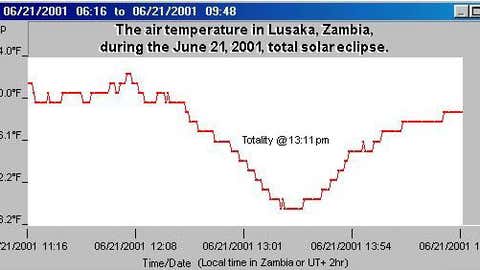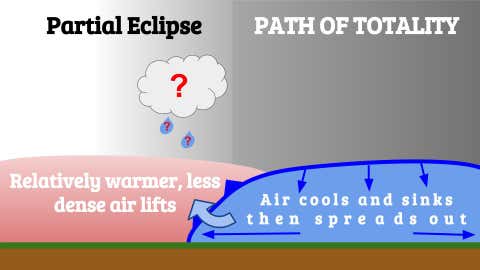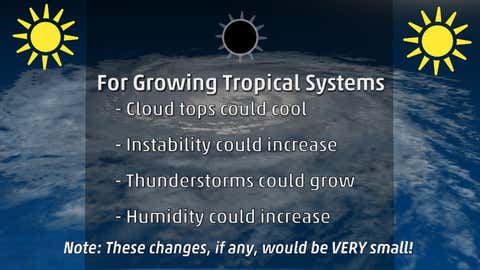
At a Glance
- Even partial eclipses have been known to change weather conditions.
- Temperatures and wind speeds often drop in the path of totality.
- Large-scale weather systems may feel slight effects.
The Great American Solar Eclipse, the first to cross the country in four decades, will provide an opportunity for the nation to observe how it can impact the weather.
From the Northwest to the Southeast, at least 75 percent of the sun will be obscured in the late morning or afternoon of Aug. 21. If the weather cooperates, everyone in the Lower 48 states will see at least a partial eclipse.
(MORE: Total Solar Eclipse Stuns Crowds Across Oregon)
To be clear, most of these weather changes will be small, perhaps imperceptible, unless you're closely watching weather instruments. Nonetheless, they will be of interest to meteorologists.

(MORE: Follow Our Coverage on Twitter)
1. Large temperature shifts, for a select few
The most obvious thing will happen is a drop in temperatures.
Temperatures should drop 5 to 15 degrees in the path of totality under clear skies. In the 2001 African solar eclipse, temperatures tumbled from the low 80s into the upper 60s.

Temperatures will drop more in the Rockies than in the Southeast and immediate Pacific coast due to lower humidity. Higher humidity values tend to keep the temperature more steady than lower humidity values.
Temperature drops will be noticeably less in areas where cloud cover hampers visibility of sun.
(MORE: Signs of Fall that can Appear in August)
2. The "Eclipse Wind"
An eclipse of the sun can change the way air moves near the ground, according to a study at the University of Reading in the United Kingdom. An "eclipse wind" is a change in wind direction and speed that occurs when the moon blocks out the sun.
More than 4,500 citizen scientists and a number of weather stations observed conditions in the path of a partial eclipse in the United Kingdom in 2015, noting a subtle lightening of the wind.
“As the sun disappears behind the moon the ground suddenly cools, just like at sunset. This means warm air stops rising from the ground, causing a drop in wind speed and a shift in its direction, as the slowing of the air by the Earth’s surface changes," according to Professor Giles Harrison at the University of Reading.
Winds fell by just over 2 mph on average and changed direction by about 20 degrees according to the study.
This effect lasts only minutes during the eclipse, and winds return to normal as soon as the sun begins to shine.
3. Eclipse-Induced Thunderstorms
In areas where it isn't cloudy, temperature drops could actually induce thunderstorms near the edge of totality.
In a process similar to the sea breeze near the coast where ocean-cooled air penetrates inland underneath relatively warmer air creating thunderstorms, an eclipse breeze could form.

If the air temperature drops far enough in the path of totality, it could create a stripe of cool air that will sink and spread out. As that cooler air spreads out, it will dip under the warmer air outside the totality zone. This could, theoretically, create lift for clouds and perhaps thunderstorms.
With the width of the path of totality being roughly 70 miles wide, there should be plenty of space for cool air to develop. The question is, will air cool quickly enough during the time of totality, roughly 1-3 minutes, to cause such an effect.
This effect would need a temperature drop of at least 10 degrees, which will only be possible where dew points – a measure of moisture – are relatively lower, which is most likely in the central and western part of the United States. Dew points have to be high enough for showers and storms to grow, and there cannot be any large sinking areas such as those common in domes of high pressure aloft.
Weather conditions will need to stack up perfectly for us to see this eclipse breeze in action.
Less Probable Effects
The next two effects are highly unlikely but are theoretically possible.
The reason that these are unlikely is that large-scale weather systems take hours or days to respond to changes in weather patterns, and the eclipse is no different.
For most locations in the path of the eclipse, darker skies will only an hour or less, which is not enough time for the atmosphere to respond.
(MORE: The Most Notorious Portion of the Atlantic Hurricane Season Has Arrived)
4. Tropical Cyclones
If, and that's a big if, a tropical storm or hurricane was in the path of a solar eclipse, and hypothetically was sitting there long enough, growing tropical systems could react to the loss of daylight.
Hurricanes and tropical storms get their energy from the warm waters of the oceans and not from the sun, but the heat from the sun does have an impact.
The daily temperature swings cause thunderstorm activity to burst at different times of the day in growing tropical cyclones.

Generally, these systems will grow in intensity during the overnight and early morning hours when the atmosphere is at its coolest. Thunderstorms grow the fastest when the temperature contrast between the ocean (which remains a nearly constant temperature day to day) and near cloud top level, typically 30,000-50,000 feet, is the greatest. This time of greatest instability occurs when the most heat has escaped to space for the day.
Weak tropical systems are often at their most active during the early morning hours because of this effect.
Hurricanes, on the hand, often are self-igniting using the ocean and inner cloud processes and do not depend as much on daily temperature swings, but they too could see cooling cloud tops.
(MORE: Hurricane, Total Solar Eclipse at the Same Time Would Be a First in Satellite Era)
It's pretty rare to get a notable tropical system in the Atlantic where the path of maximum eclipse is, but it has happened at least once.
The remnants of Hurricane Gracie in 1959 intersected the initial path of a total solar eclipse off the coast of Boston. It is very unlikely that the eclipse had any effects on that system. Interestingly, Hurricane Hannah was also active at the time of the eclipse and may have been slightly shadowed in the swath of partiality.
5. Thunderstorm Complexes
Temperature swings, especially in areas with less humidity, also have effects on thunderstorm complexes.
Generally, the hotter it is, the better a storm can flourish in its environment. Assuming all other ingredients – wind shear, mugginess, some kind of lifting mechanism – for thunderstorms are favorable, large-scale drops in temperature can cause storms to weaken.
Usually this happens when one storm runs into the cold pool of air left over by another storm, but the effect could be similar in the path of an eclipse.
Again, temperatures in more humid climates could fall 5 to 10 degrees in the path of totality, which might be enough to cause a temporary weakening of a thunderstorm cluster.
In all likelihood, there will be thunderstorms in the path of the eclipse, especially in the eastern half of the country.
(MORE: Eclipse Outlook)
6. Weather Radar
This one might be a bit of a stretch to call it weather-related, but it is something that meteorologists often watch for on radar.
Bugs, bats and other critters are often seen creeping out of their nighttime sleepy spots to feed at roughly sunset on radars across the country. The most common sightings of this are bats leaving their caves across Texas, but these sightings can take place anywhere in the country.

On the flip side, birds can sometimes be seen taking off at sunrise to gather breakfast.
Could we see both effects with this eclipse? Only time will tell, but we'll be watching.



